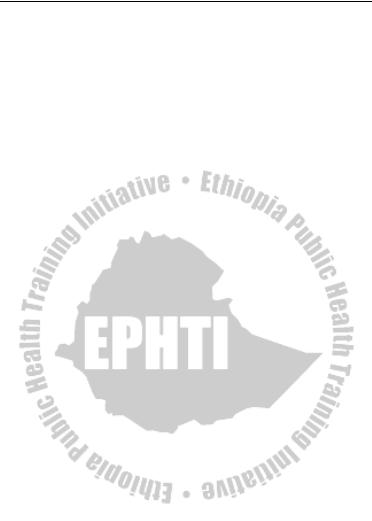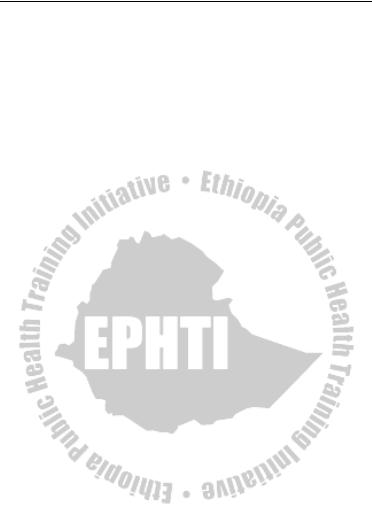
LN_Intro_PH_final
.pdf
Introduction to Public Health
health and embraces all factors, which contribute to healthful living. Hygiene is also defined as the science that deals with the establishment and maintenance of health in the individual and the group, conditions and practices conducive to health. Hygiene can be classified into community hygiene and personal hygiene. Community hygiene might include industrial hygiene, social hygiene, food hygiene, etc.
Personal Hygiene is part of hygiene, which tells us how an individual preserves, improves and maintains the health of his own mind and body. It is taking care of yourself everyday, from your hair to your feet, by following the rules of proper washing and grooming, healthful nutrition, and getting enough physical activity and rest. Personal hygiene and health are greatly affected by heredity and environment; it can be discussed in terms of constitution, posture, habit, sunshine, rest and sleep, fatigue, exercise, emotions, cleanliness of the body, mental hygiene and nutrition.
Constitution means physical make up of the body in relation to one’s health vitality or condition of mind, which may greatly be influenced by the environment. The human body is constituted of several systems of
69

Introduction to Public Health
organs. They work together although they perform a particular job to keep the human body alive and active.
Posture is attitude/ way of holding the body. Good posture is highly appreciable and a social asset because of its aesthetic value. Poor posture interferes with respiration and diaphragm movement, flow of blood, circulatory and digestive system. Congenital structure, ill fitted footwear and high heals occupation which keeps body in incorrect posture for a long time and poor nutrition are some of the causes of incorrect posture.
Habit is settled or regular tendency or practice, especially one that is hard to give up. Habits grow out of our routines. Some habits are acquired from parents through unconscious imitation. Forming of good habits will determine a child’s actions and thinking. Training in good habits both physical and mental have a definite effect on life.
Sunlight and fresh air have double beneficial action. They stimulate one’s mind and produce important effects on skin, thus improving the metabolism of the body.
Rest and sleep are needed for maintaining health. During sleep mind is set at rest. Repair and growth of
70

Introduction to Public Health
the tissues take place during sleep because during working hours our tissues and nerves are constantly subjected to wear and tear. To take rest and have sufficient amount of sleep is necessary. Fatigue is the feeling of tiredness or weariness form muscular activity. It also means weariness resulting from either bodily or mental exertion in response of stimuli to any organs’ over activity.
Exercise is the basis for the healthy body for majority of people. It is important for maintaining health and vigor and to promote growth. Ability to think and perceive is enhanced by means of exercise. Without exercise, the whole body becomes sluggish.
Emotion is a “stirred up” state of the organism; it is a subjective feeling state, which can influence perception, thinking, and behavior; usually accompanied by facial and bodily expressions; an excited state of mind based on a physiological departure from homeostasis. It includes love, hate, fear, grief, angry or joy experienced unconsciously due to some drive.
Nutrition is defined as the series of processes by which an organism takes in and assimilates food for promoting growth and replacing worn out and injured tissues.
71

Introduction to Public Health
Cleanliness of the body includes both, care of hair, teeth, eyes, ears, nails, care of the feet, hand etc. Menstrual hygiene means taking care of the sanitary condition of the vulvae. Menstruation is a normal physiological process of a normal womanhood.
Keeping personal cleanliness costs very little when it is compared with its importance. In this case, every body can practice it at home with available materials.
1.Hands and fingers nails: unclean hands considered important routes of transmission for diseases. Fingernails, if not properly cleaned and trimmed are suitable for accumulation of dirt and
microorganisms. As a result, food can be contaminated during preparation and pathogens can directly transfer into the mouth when eating.
Control measure to prevent the transmission of diseases form hands and fingernails:
•Keep fingernails always clean and short
•Use detergent (soap) for the hand before food preparation and eating
•Use hand washing after eating and toilet visit including some other activities
72

Introduction to Public Health
NB. Improper hand washing is not better than hand washing not at all. Proper hand washing reduces the microbial load though it is not as remarkable as washing using soaps.
2.The skin: Sweat and oily secretions from the skin cause dust to stick on its surface. This clogs the skin pores and interferes with the natural function of the skin. Human skin serves as physical barrier and also has self disinfectant power. The disinfectant power of skin increases when the skin is clean
More over, the bacteria can readily breed on unclean surface of the skin to cause various diseases and undesirable odor. Therefore, proper skin cleanliness is very relevant to break the transmission of disease.
3.Clothes: help to protect our body from harsh weather conditions. However, unclean cloths contribute to the multiplication of pests and the spread of pests born disease like relapsing fever. To prevent such health problems regular day and night clothes washing and ironing is advisable.
4.The mouth and teeth: Can harbor microorganisms when food particles left between
73

Introduction to Public Health
the teeth. The microorganism uses this food as a nutrient, multiplies in larger numbers, and can cause gum and tooth disease as well as bad breath. Therefore, to prevent the problem regular tooth brushing is relevant.
5.The head: unclean hair and scalp can harbor different microorganisms and pests, like lice, which can transmit disease. Therefore, to prevent the problem regular washing with soap and warm water is highly encouraged.
6.The nose: It contains hairs in the nostrils that filter dirt and microorganism from the air. Thus, the nose serves as a protecting devise against the entrance of harmful substances in to lungs and circulatory system. For this reason, the nostrils should at all times be kept clean by using a clean handkerchief or blowing at intervals to remove the accumulated dusts and spores.
7.The eye: Dirty eyes attract common housefly. Microorganisms carried by the flies’ legs can be deposited in or near the eyes and may cause disease like trachoma, which eventually lead to blindness. Regular face washing with soap can break the transmission of such diseases
74

Introduction to Public Health
8.The Genitalia: Shaving the hair is one of the main important parts for the genital hygiene. It helps to avoid the harborage of pests and make cleaning of the genital organ easier. Cleaning of the genital areas can be done during general body cleaning or taking shower. However, there are conditions when one needs special cleaning of genital areas. These are before and after sexual intercourse, during menstruation period, before and after delivery.
6.3Exercise
Discuss the role of hygiene in the prevention of diseases.
Mention and discuss some of diseases that can be prevented by certain aspects or practices of personal hygiene
75

Introduction to Public Health
CHAPTER SEVEN
HEALTH AND DEVELOPMENT
7.1Learning objectives
At the end of this course, the students are expected:
Differentiate between development and economic growth.
Describe the relationship between the health sector and development
Identify and define relationships existing between individual and community health and various socio-economic conditions.
7.2Introduction
Individuals in good health are better able to study, learn and be more productive in their work. Improvements in standard of living have long been known to contribute to improved public health; however, the course has not always been recognized. Investment in health care was not considered a high priority in many countries where
76

Introduction to Public Health
economic considerations directed investment to the “productive” sectors such as manufacturing and largescale infrastructure projects, such as hydroelectric dams.
Socially oriented approach sees investment in health as necessary for the protection and development of “human capital” just as investment in education is needed for the long-term benefit of the economy of a country. According to the World Development Report by World Bank in1993: Investing in health, articulated a new approach to economic growth in which health, along with education and social development are considered essential contributors for economic development.
Development on the other hand should be the concern of all in the developing countries. The health planner, manager, and others are equally charged with that concern and must be knowledgeable of what development implies and the role health should play in the development of ones country.
Hence, it is important to know what development means, how does it differ from economic growth? What role does health play in development?
77

Introduction to Public Health
What is development?
Development has been variously defined. The modern view of development perceives it as both a physical reality and a state of mind in which society has, through some combination of social, economic and institutional processes, secured the means for obtaining a better life.
Development in all societies must consist of at least the following:
To increase the availability, distribution and accessibility of life sustaining goods such as food, shelter, health, security and protection to all members of society.
To raise standards of living including higher incomes, the provision of more jobs, better education and better health and more attention to cultural and humanistic values so as to enhance not only material well-being, but also to generate greater individual, community and national esteem.
To expand the range of economic and social opportunities and services to individuals and communities by freeing them from servitude,
78
